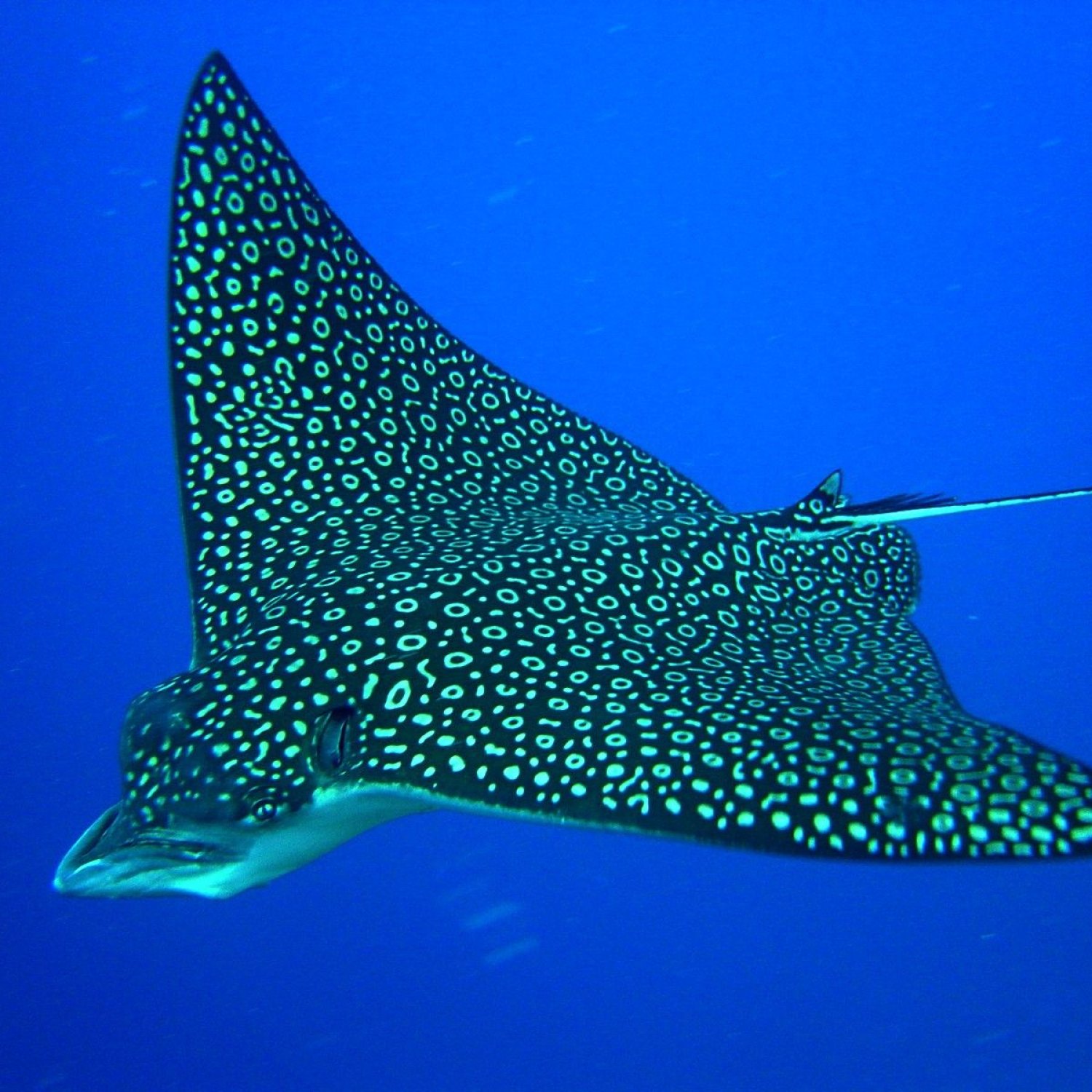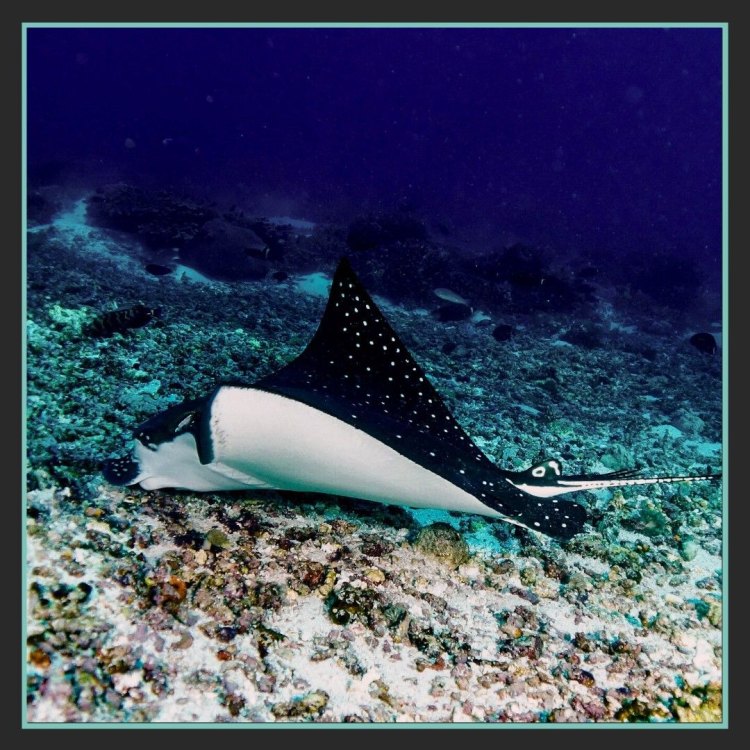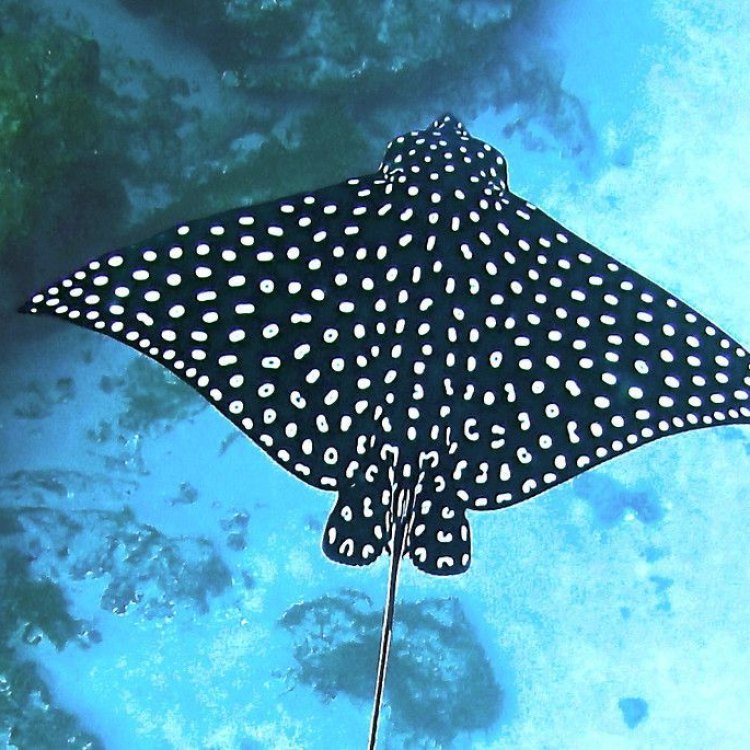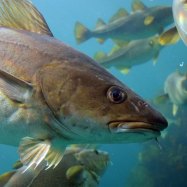
Eagle Ray
Up to 9 feet (2.7 meters)
Eagle Rays are majestic creatures found in shallow waters near coastlines. With a flattened body and broad pectoral fins, they can grow up to 9 feet long. Belonging to the Myliobatidae family, these rays are often seen gliding gracefully through the ocean, making them a sight to behold. Keep an eye out for these fascinating animals on your next beach visit!
Animal Details Summary:
Common Name: Eagle Ray
Kingdom: Animalia
Habitat: Tropical and warm coastal waters
The Magnificent Eagle Ray: A Majestic Creature of the Ocean
The ocean is full of wondrous creatures, but one that stands out with its unique appearance and behavior is the Eagle Ray. These majestic creatures are a sight to behold with their striking black and white coloration and graceful movements in the water. In this article, we will explore the fascinating world of the Eagle Ray, from its scientific classification to its habitat, feeding habits, and overall significance in our oceans.The Eagle Ray, scientifically known as Aetobatus narinari, is a member of the animal kingdom, specifically the Phylum Chordata Eagle Ray. It belongs to the class Chondrichthyes, which includes all cartilaginous fish, such as sharks and rays. The Eagle Ray falls under the order Rajiformes and the family Myliobatidae, making it a close relative of other species like the manta ray and devil ray. These remarkable creatures can be found in tropical and warm coastal waters, particularly in the Atlantic and Pacific oceans.
While the name "Eagle Ray" may suggest that this creature is a type of bird, it is, in fact, a fish. Its name comes from its unique appearance, resembling an eagle with its wings spread, gracefully gliding through the ocean. This is further emphasized by its broad pectoral fins, which give it a distinct eagle-like appearance.
Appearance and Behavior
The Eagle Ray's coloration is dark gray to black on its dorsal (top) side, while its ventral (bottom) side is white. This coloration serves as a form of camouflage, helping it blend in with its surroundings and avoid potential predators. This is a common defense mechanism in many ocean creatures Embolotherium.The body shape of an Eagle Ray is another unique feature. As mentioned earlier, its pectoral fins are broad and resemble the wings of an eagle, giving it its name. Its body is also flattened and elongated, which enables it to move through the water with ease and grace. The Eagle Ray can reach lengths of up to 9 feet (2.7 meters), making it one of the largest species of ray in the ocean.
One of the most remarkable behaviors of the Eagle Ray is their ability to leap out of the water. They do this by beating their pectoral fins against the surface of the water, propelling themselves upwards. This behavior is believed to have several purposes, such as escaping predators, shaking off parasites, and attracting mates during the mating season.
Habitat and Distribution
Eagle Rays are found in various countries, making them a widely distributed species. They can be found in both the Atlantic and Pacific oceans, from the eastern coast of the United States to as far as Japan. They also inhabit the tropical and warm coastal waters of countries like Australia, Brazil, and even the Philippines.These magnificent creatures prefer shallow waters near coastlines, making them a common sight for divers and snorkelers. They can also be found in sandy areas, seagrass beds, and coral reefs, where they feed on various marine organisms.
Feeding Habits
Like most other rays, the Eagle Ray is carnivorous, meaning it feeds on other animals to survive. Its diet consists of small fish, crustaceans, and mollusks, which it finds by swimming close to the bottom of the ocean floor. Its flattened body and broad pectoral fins allow it to glide effortlessly through the water, making it easier for it to hunt and catch its prey.One interesting fact about the Eagle Ray's feeding habits is that it has unique tooth structures that work together as a conveyor belt. This enables it to crush and grind the shells of crustaceans and mollusks before swallowing them whole. This adaptation is crucial for their survival as it allows them to consume a wider variety of prey.
Importance in the Ocean Ecosystem
Every creature in the ocean plays a crucial role in maintaining the delicate balance of the ecosystem, and the Eagle Ray is no exception. As a predator, it helps control the population of its prey, preventing them from overpopulating and potentially damaging their environment. Additionally, their flattened bodies help stir up sediments on the ocean floor, which is essential for the health of coral reefs.Unfortunately, like many other marine animals, the Eagle Ray's population is facing threats due to human activities. Factors such as overfishing and pollution pose a significant risk to their survival. These magnificent creatures are also often caught as bycatch in fishing nets, causing harm to their populations. Therefore, it is vital to raise awareness about their conservation and take necessary measures to protect them and the ocean they inhabit.
Conclusion
The Eagle Ray is a remarkable creature with unique features and behaviors that leave us in awe and wonder. From its graceful movements in the ocean to its crucial role in maintaining the balance of the ecosystem, it is undoubtedly a significant species in our oceans. It is our responsibility to ensure its survival and protect its habitat to maintain the beauty and diversity of our oceans for generations to come.In conclusion, the Eagle Ray is a true testament to the wonders of the animal kingdom, and its presence in our oceans serves as a reminder to appreciate and protect these magnificent creatures. Next time you catch a glimpse of an Eagle Ray while diving or snorkeling, take a moment to admire its beauty and remember the importance of its existence in our oceans.

Eagle Ray
Animal Details Eagle Ray - Scientific Name: Aetobatus narinari
- Category: Animals E
- Scientific Name: Aetobatus narinari
- Common Name: Eagle Ray
- Kingdom: Animalia
- Phylum: Chordata
- Class: Chondrichthyes
- Order: Rajiformes
- Family: Myliobatidae
- Habitat: Tropical and warm coastal waters
- Feeding Method: Carnivorous
- Geographical Distribution: Atlantic and Pacific Oceans
- Country of Origin: Various countries
- Location: Shallow waters near coastlines
- Animal Coloration: Dark gray to black on top with a white belly
- Body Shape: Flattened body with broad pectoral fins
- Length: Up to 9 feet (2.7 meters)

Eagle Ray
- Adult Size: 6 to 9 feet (1.8 to 2.7 meters)
- Average Lifespan: Up to 25 years
- Reproduction: Ovoviviparous
- Reproductive Behavior: Mating occurs in groups called leks
- Sound or Call: Unknown
- Migration Pattern: Some populations migrate
- Social Groups: Solitary or form small groups
- Behavior: Active swimmers, often seen jumping out of the water
- Threats: Habitat loss, overfishing, accidental capture in fishing gear
- Conservation Status: Vulnerable
- Impact on Ecosystem: Top predator, helps regulate prey populations
- Human Use: Fishing, ecotourism
- Distinctive Features: Long, slender tail with a stinging spine
- Interesting Facts: Eagle rays are capable of leaping out of the water and performing acrobatic flips
- Predator: Sharks, large predatory fish

Aetobatus narinari
The Magnificent Eagle Ray: A Top Predator in Danger
The ocean is home to some of the most fascinating and mysterious creatures on our planet. Among them is the majestic eagle ray, a fish that is loved by divers and feared by its prey. With its distinctive features and interesting behaviors, the eagle ray stands out in the vast expanse of the sea. However, this magnificent creature is facing numerous threats that are putting its survival at risk PeaceOfAnimals.Com. In this article, we will explore the unique features of the eagle ray, its vital role in the ecosystem, and the dangers it is currently facing.The eagle ray, or the myliobatidae family, is a type of cartilaginous fish that is closely related to sharks and skates. They can be found in tropical and temperate waters around the world, including the Atlantic, Pacific, and Indian Oceans. The name "eagle ray" is derived from their wingspan, which closely resembles the wings of an eagle. Their body is flat and disc-shaped, with a long, slender tail that can reach up to 6 to 9 feet in length. They can weigh up to 500 pounds, making them one of the largest rays in the ocean.
The average lifespan of an eagle ray is up to 25 years, and they reach maturity around the age of 4 to 6. In terms of reproduction, these creatures are ovoviviparous, meaning they give birth to live young. However, unlike most bony fish species that carry their eggs inside them until hatching, eagle rays retain the fertilized eggs inside their body until the pups are fully developed European Wildcat. They can give birth to 2 to 4 pups at a time, which are miniature versions of their parents.
One of the most interesting reproductive behaviors of eagle rays is their mating rituals. Mating occurs in groups called leks, where multiple males compete for the attention of a female. The male rays will use their unique suction disc on their head to attach themselves to the female's body and mate with her. This behavior is not commonly seen in other fish species, making the eagle ray a unique and intriguing creature to study.
One thing that remains a mystery is the sound or call of the eagle ray. As they are not commonly kept in captivity, scientists have not yet been able to identify any sounds they may make. However, it is known that they have a keen sense of hearing and are able to detect sound waves generated by their prey and predators.
Some populations of eagle rays are known to migrate, although the exact patterns and reasons are still not fully understood. It is believed that they migrate in search of food or for reproductive purposes. Some populations are also known to form small groups, while others are solitary creatures. This suggests that there may be differences in behavior and social structure among different eagle ray populations.
Eagle rays are active swimmers and are often seen gliding gracefully through the water, occasionally jumping out of the water in what is known as breaching behavior. They can also perform acrobatic flips, a behavior that has fascinated people for centuries. This stunning display of agility and athleticism has made them a popular attraction for ecotourism activities such as diving and snorkeling.
However, despite its incredible abilities and unique attributes, the eagle ray is facing multiple threats that are endangering its survival. Habitat loss due to coastal development, pollution, and climate change is a significant concern for these creatures. As they prefer shallow coastal areas, they are highly susceptible to the destruction of their habitats for various human activities. This not only affects the eagle ray but can also have a devastating impact on the entire marine ecosystem.
Overfishing is another major threat to the eagle ray population. They are often caught as bycatch in fishing gear such as trawls and gillnets, which are not specifically targeting them. With their slow reproductive rate, even low levels of fishing pressure can have a significant impact on their population. In some parts of the world, they are also intentionally targeted for their meat and other body parts, which are used in traditional medicine.
As a top predator, the eagle ray plays a vital role in the ocean's delicate balance. They help regulate prey populations, which in turn, has a cascading effect on the health of the entire ecosystem. With their sharp, stinging spines, they are also a natural defense mechanism against predators, including sharks and large predatory fish. Any decline in the eagle ray population can have severe consequences on the ocean's health and biodiversity.
Despite their conservation status being listed as "vulnerable" by the IUCN, there is still hope for the survival of the eagle ray. Governments and conservation organizations are working towards creating protected areas and implementing fishing regulations to reduce the impact on their population. Public awareness campaigns and responsible tourism practices are also helping in raising awareness about the importance of these magnificent creatures and the need to protect them.
Unfortunately, not all human interactions with eagle rays are positive. These creatures are also facing threats from those who see them as a commercial resource. They are often caught and killed for their flesh and other body parts, which are used in traditional medicine. This senseless exploitation is further endangering the already vulnerable eagle ray population.
In conclusion, the eagle ray is undoubtedly a remarkable creature with unique features and behaviors that make it an important part of the ocean's ecosystem. It is also a popular and valuable species for ecotourism and fisheries. However, the current threats facing these creatures are putting their survival at risk. Urgent conservation efforts are needed to protect and preserve the eagle ray population, not only for their sake but for the sake of our oceans as a whole. As responsible stewards of the Earth, it is our responsibility to ensure that these fascinating creatures continue to thrive in their natural habitats for generations to come.

The Magnificent Eagle Ray: A Majestic Creature of the Ocean
Disclaimer: The content provided is for informational purposes only. We cannot guarantee the accuracy of the information on this page 100%. All information provided here may change without prior notice.












